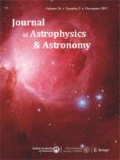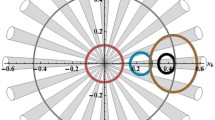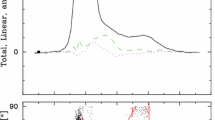Abstract
We investigate the emission properties of the pulsars that exhibit different drifting subpulses in different pulse profile components based on the model for obliquely rotating pulsar magnetospheres of multiple emission states. Emission from subpulses is assumed coming from m discrete areas located on carousels around the magnetic axis and flowing at rates determined by the \(\varvec{E}\times \varvec{B}\) drift. An emission state is defined by this drift, and a change in the emission state corresponds to a change in the drift velocity. The model is applied to eight pulsars, all displaying drifting subpulses of particular properties along two different drift-bands at different parts of the pulse profile at 21 cm observing wavelength. Simulation is performed to identify the emission states for the different drifting subpulses and the associated values of m in the emission region. The results show that drifting subpulses in different profile components correspond to particular emission states and m, and that different emission states and m can coexist in an emission region. We determine the circulation time for plasma around the magnetosphere and show that it is related to the obliquity angle. By comparing with three other pulsars that display drifting subpulses of a single drift-band, we find that drifting subpulses demonstrate similar properties when considering the different drift-bands separately. We speculate, based on our results, that the coexistence of different drifting subpulses within a pulse profile may require additional mechanism, and the phenomenon is more common in pulsars with small obliquity angle.






Similar content being viewed by others
References
Allen M. C. 1985, MNRAS, 215, 111
Arons J., Scharlemann E. T. 1979, ApJ, 231, 854
Arons J. 1981, ApJ, 248, 1099
Bhattacharyya B., Gupta Y., Gil J., Sendyk M. 2007, MNRAS, 377, L10
Camilo F., Ransom S. M., Chatterjee S., Johnston S., Demorest P. 2012, ApJ, 746, 63
Cheng K. S., Ruderman M. A., Zhang L. 2000, ApJ, 537, 964
Clemens J. C., Rosen R. 2004, ApJ, 609, 340
Cole T. W. 1970, Nature, 227, 788
Cordes J. M. 1978, ApJ, 222, 1006
Cordes J. M. 1979, Space Sci. Rev., 24, 567
Deshpande A. A., Rankin J. M. 1999, ApJ, 524, 1008
Deshpande A. A., Rankin J. M. 2001, MNRAS, 322, 438
Drake F. D., Craft H. D. 1968, Nature, 220, 231
Edwards R. T., Stappers B. 2002, A&A, 393, 733
Fawley W. M., Arons J., Scharlemann E. T. 1977, ApJ, 217, 227
Filippenko A. V., Radhakrishnan V. 1982, ApJ, 263, 828
Fung P. K., Khechinashvili D., Kuijpers J. 2006, A&A, 445, 779
Gajjar V., Yuan J. P., Yuen R., et al. 2017, ApJ, 850, 173
Gangadhara R. T. 2004, ApJ, 609, 335
Gil J. A., Sendyk M. 2000, ApJ, 541, 351
Gil J. A., Sendyk M. 2003, ApJ, 585, 453
Gil J., Melikidze G. I., Geppert U. 2003, A&A, 407, 315
Godoberidze G., Machabeli G. Z., Melrose D. B., Luo Q. 2005, MNRAS, 360, 669
Goldreich P., Julian W. H. 1969, ApJ, 157, 869
Hibschman J., Arons J. 2001, ApJ, 554, 624
Hones E. W. J., Bergeson J. E. 1965, JGR, 70, 4951
Jones P. B. 1984, MNRAS, 209, 569
Kazbegi A. Z., Machabeli G. Z., Melikidze G. I. 1991, AuJPh, 44, 573
Kijak J., Gil J. 2003, A&A, 397, 969
Kramer M., Lyne A. G., O’Brien J. T., Jordan C. A., Lorimer D. R. 2006, Science, 312, 549
Lorimer D. R., Lyne A. G., McLaughlin M. A., et al. 2012, ApJ, 758, 141
Lyne A. G., Manchester R. N. 1988, MNRAS, 234, 477
Lyne A. G., Stappers B. W., Freire P. C. C., et al. 2017, ApJ, 834, 72
Lyubarskii Y. E. 1996, Astron. Astrophys., 308, 809
Manchester R. N., Taylor J. H. 1977, Pulsars (San Francisco: W. H. Freeman)
Melrose D. B. 1967, Planet. Space. Sci., 15, 381
Melrose D. B., Yuen R. 2012, ApJ, 745, 169
Melrose D. B., Yuen R. 2014, MNRAS, 437, 262
Melrose D. B., Yuen R. 2016, J. Plasma Phys., 82, 635820202
Michel F. C., Li H. 1999, Physics Reports, 318, 227
Mitra D., Rankin J. M. 2008, MNRAS, 385, 606
Pétri J., Heyvaerts J., Bonazzola S. 2002, Astron. Astrophys., 384, 414
Pétri J. 2007, A&A, 464, 135
Rankin J. M., Wright G. A. E. 2008, MNRAS, 385, 1923
Ruderman M. 1972, Ann. Rev. Astr. Ap., 10, 427
Ruderman M., Sutherland P. G. 1975, ApJ, 196, 51
Scharlemann E. T., Arons J., Fawley W. M. 1978, ApJ, 222, 297
Smits J. M., Mitra D., Stappers B. W., et al. 2007, A&A, 465, 575
Sutton J. M., Stelin D. H., Price R. M., Weimer R. 1970, ApJ, 159, L89
Szary A., van Leeuwen J. 2017, ApJ, 845, 95
Timokhin A. N. 2010, MNRAS, 408, L41
van Leeuwen A. G. J., Stappers B. W., Ramachandran R., Rankin J. M. 2003, A&A, 399, 223
van Leeuwen A. G. J., Timokhin A. N. 2012, ApJ, 752, 155
Weltevrede P., Edwards R. T., Stappers B. 2006, A&A, 445, 243
Wen Z. G., Chen J. L., Hao L. F., et al. 2020, ApJ, 900, 168
Xu R. X., Qiao G. J., Zhang B. 1999, ApJL, 522, L109
Xu R. X. 2006, Chin. J. Astron. Astrophys., 6, 279
Yuen R., Melrose D. B. 2014, PASA, 31, e039
Yuen R. 2019, MNRAS, 486, 2011
Acknowledgments
We thank Willem Baan, Dalei Li and XAO pulsar group for useful discussions. The authors would like to thank the anonymous referee for helpful comments which have improved the presentation of the paper. RY is supported by the 2018 Project of Xinjiang Uygur Autonomous Region of China for Flexibly Fetching in Upscale Talents, and Natural Science Foundation of China (grant nos U1838109, 11873080, 12041301), and partly supported by Xiaofeng Yang’s Xinjiang Tianchi Bairen project and CAS Pioneer Hundred Talents Program.
Author information
Authors and Affiliations
Corresponding author
Appendices
Appendix A. The electric and magnetic fields
The electric field in the model for pulsar magnetosphere of multiple emission states is given by Equation (9) in Section 2 and reproduced below
Here, the inductive electric field due to the obliquely rotating time-dependent magnetic dipole, \(\varvec{p} =\varvec{p}(t-r/c)\), in vacuo is signified by
and the vector potential due to the rotating dipole is (Melrose & Yuen 2014)
where r and \(\varvec{x}\) are the radial distance from the stellar center and position vector, respectively. Since \(\varvec{p}\) is a function of \(\alpha\) in the observer’s frame (see Appendix B), \(\varvec{E}_{\mathrm{pot}}\) is also a function of \(\alpha\). Both \(\varvec{x}\) and \(\varvec{p}\) can be determined uniquely at given coordinates for known \(\zeta\) and \(\alpha\). The unit vector of the dipolar magnetic field, \(\varvec{B}_{\mathrm{dip}}\), is represented by the symbol \(\varvec{b}\), with the magnetic field given by,
where \(1/r^3\) term corresponds to the dipolar term and the radiative terms are denoted by the terms \(\propto 1/r^2\) and \(\propto 1/r\). We note that all terms in Equation (A4) are functions of \(\alpha\) (e.g., see the paper by Cheng et al. (2000)).
In spherical coordinates, the expression for \(\varvec{E}_{\mathrm{ind}}\) has the form given by
with the initial conditions chosen for the magnetic axis being in the plane \(\phi =0\). Since \(\varvec{E}_{\mathrm{ind}}\) is proportional to \(\sin \alpha\), it vanishes for \(\alpha =0\). Therefore, \(\varvec{E}_{\mathrm{ind}}\) and \(\varvec{E}_{\mathrm{pot}}\) are both functions of \(\alpha\), and hence \(\varvec{E}\) is also a function of \(\alpha\).
Appendix B. Transformation matrices
The magnetic and rotation axes of a pulsar may be organized in Cartesian coordinates in such a way that \(\hat{\mathbf{p}}={\hat{\mathbf{z}}}_b\) and \({{\hat{\omega }}_\star }={\hat{\mathbf{z}}}\). Here, the unit vectors relative to the magnetic and observer’s frames are given by \({\hat{\mathbf{x}}}_b,{\hat{\mathbf{y}}}_b ,{\hat{\mathbf{z}}}_b\) and \({\hat{\mathbf{x}}},{\hat{\mathbf{y}}},{\hat{\mathbf{z}}}\), respectively. The matrix for transformation between the unit vectors are given by
such that
where \({{\mathsf {\mathbf{{R}}}}}^\mathrm{T}\) is the transpose of \({{\mathsf {\mathbf{{R}}}}}\). The corresponding unit vectors for radial, polar and azimuthal in spherical coordinates are represented by \({\hat{\mathbf{r}}}, {{\hat{\theta }}}_b,{{\hat{\phi }}}_b\) and \({\hat{\mathbf{r}}}, {{\hat{\theta }}},{{\hat{\phi }}}\), with
Here,
Then, the transformation of the rotating magnetic dipole, \(\varvec{p}\), from the magnetic frame in Cartesian coordinates to the observer’s frame in spherical coordinates follows by using Equations (B2) and (B3).
Rights and permissions
About this article
Cite this article
Tu, Z.Y., Yuen, R. & Han, X.H. Properties of pulsar subpulse drifting in different profile components. J Astrophys Astron 43, 28 (2022). https://doi.org/10.1007/s12036-022-09808-9
Received:
Accepted:
Published:
DOI: https://doi.org/10.1007/s12036-022-09808-9




